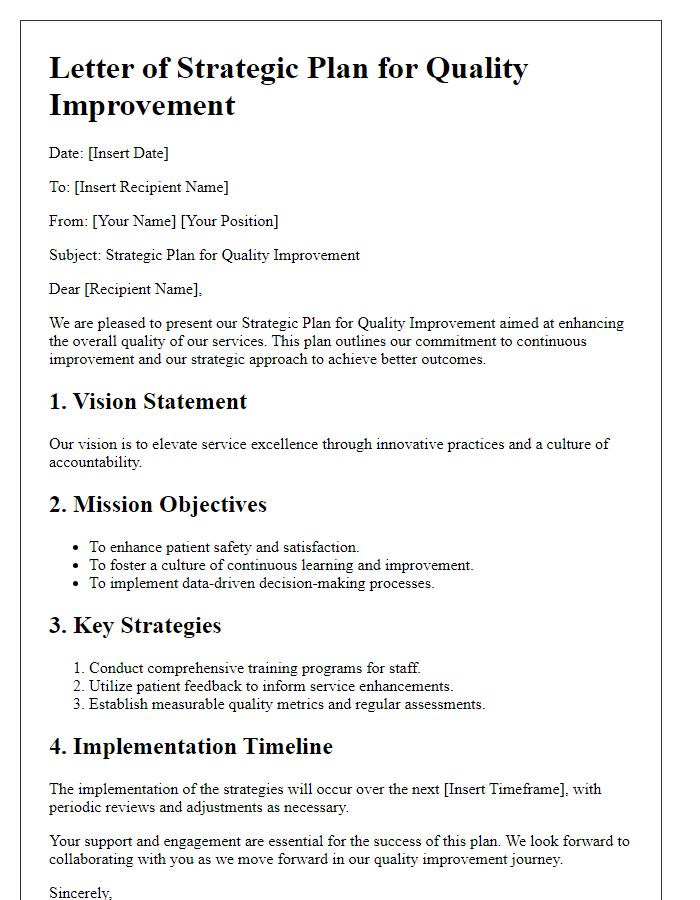Are you ready to take your organization's quality standards to the next level? In this article, we'll explore a comprehensive letter template designed specifically for proposing a quality improvement initiative. We'll walk you through the essential components to include and how to effectively communicate your vision to stakeholders. So, let's dive in and discover how to craft an impactful proposal that can spark meaningful change!

Clear Objective Statement
Quality improvement initiatives focus on enhancing processes and outcomes within organizations, such as healthcare facilities or manufacturing companies. A clear objective statement is crucial, articulating specific goals, such as reducing patient wait times by 30% within six months at St. Mary's Hospital or decreasing production defects to less than 1% at Acme Manufacturing. The statement should also include relevant metrics, like tracking patient satisfaction scores through surveys, or monitoring defect rates through quality control inspections. By defining these objectives, stakeholders can align their efforts toward measurable improvements, ensuring that resources are efficiently utilized for targeted enhancements.
Specific Goals and KPIs
In a quality improvement initiative proposal, defining specific goals and associated Key Performance Indicators (KPIs) is essential for measuring success. Goals should be SMART (Specific, Measurable, Achievable, Relevant, Time-bound). For example, reducing patient wait times in emergency departments (ED) to under 30 minutes within six months can be a clear target. KPIs might include measuring average wait time, patient satisfaction scores from surveys, and the number of patients seen within the targeted timeframe. Implementing a real-time tracking system for wait times across the ED can support continuous monitoring. Regular review meetings should occur monthly to assess progress against goals, allowing for timely adjustments to methods and strategies.
Stakeholder Engagement Plan
A quality improvement initiative, focused on enhancing patient care in healthcare systems, requires a detailed Stakeholder Engagement Plan. Stakeholders, including healthcare professionals, patients, family members, and administrators, play a critical role in determining the initiative's success. Engaging stakeholders through regular meetings, feedback surveys, and collaborative workshops can foster open communication and transparency. Prioritizing diverse representation (race, gender, and profession) among stakeholders enables a wider range of perspectives, ensuring that all voices contribute to the development process. Establishing clear objectives and timelines for stakeholder involvement will help track progress and commitment. Furthermore, acknowledging contributions through recognition initiatives can strengthen relationships, boosting morale and fostering a culture of continuous improvement.
Resource and Budget Outline
A quality improvement initiative proposal requires a comprehensive resource and budget outline to facilitate successful implementation and evaluation. Essential resources include trained personnel (project managers, quality analysts, and compliance officers), technological tools (software platforms for data collection and analysis), and physical materials (office supplies for workshops). Additionally, budget allocation must encompass personnel costs, estimated at $80,000 annually for a dedicated staff, alongside software subscriptions, which may average $2,000 per year for licenses. Training sessions, accounting for approximately $5,000, will enhance team capabilities and adherence to quality standards. Miscellaneous expenses, such as travel for site visits or stakeholder meetings, should also be anticipated, with a projected cost of around $3,000. A detailed financial outline ensures transparency and supports the initiative's sustainability over its projected timeline of 12 months, thereby promoting continual improvement in organizational quality standards.
Timeline and Milestones
A quality improvement initiative requires a well-structured timeline and clearly defined milestones to ensure effective implementation. Starting with a project kickoff meeting scheduled for January 15, 2024, stakeholders will outline the project's vision and objectives. The first milestone, completion of the current state analysis, will be achieved by February 28, 2024, allowing for a clear understanding of existing processes and areas for improvement. By March 15, 2024, the team will finalize the design of the new process, incorporating feedback from key stakeholders. Implementation will commence on April 1, 2024, with an anticipated duration of three months, culminating in a full rollout by June 30, 2024. Subsequently, a review phase will take place in July 2024 to assess the effectiveness of changes, ensuring that quality standards are met and areas for further enhancement are identified. Regular progress updates will be communicated bi-weekly throughout the project to maintain transparency and address any emerging challenges promptly.













Comments